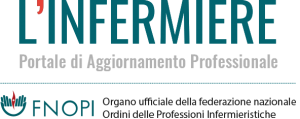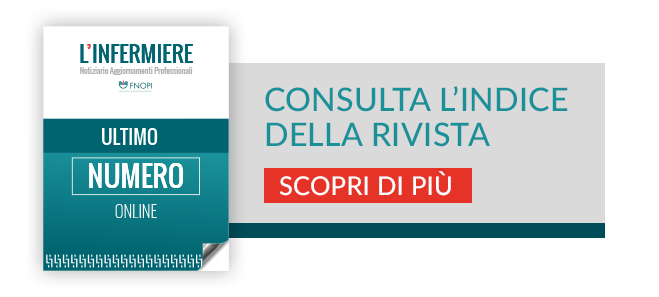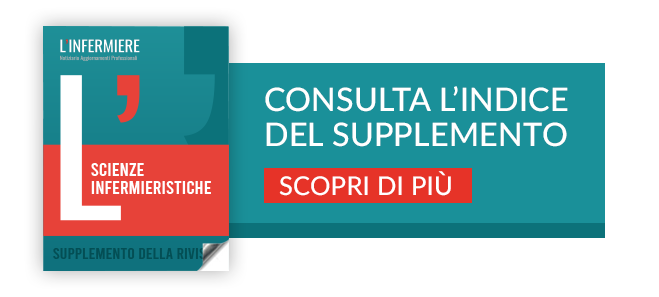L’INFERMIERE ONLINE
Quarterly journal structured over four sections: NURSING SCIENCES; CONTRIBUTIONS, EXPERIENCES and BOOK REVIEW. The main objective of the journal is to promote the development and dissemination of scientific contributions relating to theory, the clinical/assistance field, education, organization and other areas of disciplinary interest.
Nursing Sciences is an open access peer reviewed supplement of L’Infermiere online, a journal of the National Council of Nursing (FNOPI), and publishes 4 issues per year. The purpose of Nursing Sciences is to publish scientific articles related to education, nursing management and clinical practice. The articles are indexed on CINAHL.
Preparing an article for Submission
Articles should be structured according to the following sections:
- Title (both in Italian and English)
- Abstract: in Italian and English for a maximum of 250 words
- Keywords: 2 to 5 in Italian and English
- Introduction/background
- Objective(s)
- Methods
- Results
- Discussion and conclusions
- References
- Disclaimer
- Source(s) of support
General requirements
Original articles and literature reviews are published in this section. For both categories of articles, the maximum word limit is 8,000 (quotations are included in the total word count while abstracts, references, tables and figures are excluded).
Original article
Abstract: maximum 250 words, no abbreviations. Structured in the following subheadings: Introduction (state what is already known about this topic); Objectives; Methods (for both qualitative and quantitative studies include information about the methodology); Results (do not report P-values, confidence intervals and other statistical parameters); Conclusions (indicate what this study adds to the topic).
Keywords: indicate no more than 5 keywords (Keywords should be taken from the recommended ones of the Medical Subject Headings of the US National Library of Medicine (https://www.nlm.nih.gov/mesh/).
Structure of the main paper: introduction, objectives, methods, results, discussion and conclusion.
References: maximum 50.
Literature Review
Abstract: maximum 250 words, no abbreviations. Structured in the following subheadings: Introduction (state what is already known about this topic); Objectives; Methods (report information about the methodology); Results (report the principal results of review); Conclusions (indicate what this review adds to the topic).
Keywords: indicate no more than 5 keywords (keywords should be taken from the recommended Medical Subject Headings of the US National Library of Medicine (https://www.nlm.nih.gov/mesh/).
Structure of the main document: reviews should be structured in the following subtitles Background; Objectives; Methods; Results; Discussion and Conclusion.
References: maximum 70.
Figures, tables and illustrations
Figures and tables should be chosen according to criteria of clarity and simplicity, numbered progressively in Arabic numerals, and accompanied by brief and comprehensive legends. In the text, the position of insertion should be indicated between round brackets. Diagrams and illustrations, designed to facilitate the understanding of the text, must be submitted to the journal in an accurate graphic format, so that they can be reproduced without modification. For images depicting patients or persons, the authors must submit a signed consent from the persons concerned allowing publication, or the images must be edited to avoid recognition of the persons depicted.
References
References should follow the standards summarized in the Harvard Style (International Committee of Medical Journal Editors, Uniform Requirements for Manuscripts Submitted to Biomedical Journals, update2008 – http://www.icmje.org/). All articles must be supported by up-to-date references. Accurate bibliographic citations and bibliography are prerequisites for publication.
Bibliographic quotations used in the body of the text should be included with an indication of the author and the year of publication. The name and date are contained in brackets, except in cases where the author’s surname is cited throughout the text. For example: A pleasant working environment and adequate staff management are components of job satisfaction (Marriner, 1982). Or: Marriner (1982) argues that a pleasant working environment and adequate staff management are components of job satisfaction.
Each quotation must find the corresponding extended bibliographic reference in the list of References. If two sources by the same author, published in different years, are to be cited, the name in brackets will be followed by the years of publication (Bianchi 2002, 2004). Citations in the body of the text of works with more than two authors should be reduced to a maximum of two authors with the diction et al. (Bianchi and Verdi et al., 2005). In the bibliography, which is placed at the end of the publication proposal, all references indicated in the bibliographic notes and any other essential reference literature should be listed in alphabetical order. Here are some examples.
An article from a journal
Halpern S.D., Ubel P.A., Caplan A.L. (2002) Solid-organ transplantation in HIV-infected patients. N Engl JMed, 347(4), 284-7. The name of the journal and other data should be cited as follows: [author: surname, first name(s) initial(s)] [(year of publication)] [Article title]. [journal name], [Volume (number)], [pages]. If two sources signed by the same author and published in the same year are to be quoted, the first must be referred to as (Bianchi 2004a), the second as (Bianchi 2004b). The same criterion will be used in the list at the end of the article.
Citations in the body of the text of papers with more than two authors (Bianchi, Verdi et al. 2005) can indifferently be included in the final bibliography with all the names, or only the two reported in the bibliographic citation in brackets: Bianchi G. e Verdi F. et al. (2005) L’infermieristica del futuro. L’Infermiere, 12(6), 18-22. Or: Bianchi G., Verdi F., Rossi A., Gialli V. (2005) L’Infermieristica del futuro. L’infermiere, 12(6), 18-22.
A book
Murray PR, Rosenthal KS, Kobayashi GS, Pfaller MA (2003) Medical microbiology. 4th ed. St. Louis: Mosby.
A chapter within a book
Meltzer P.S., Kallioniemi A., Trent J.M. (2004) Chromosome alterations in human solid tumors. In: Vogelste B., Kinzler K.W., editors. The genetic basis of human cancer. New York: McGraw-Hill, 93-113.
A newspaper
Verdi F. (2007) Le professioni non mediche e la nuova normativa di riferimento. La Repubblica, 12 August, 26.
Conference proceedings
Dupont B. (1988) Bone marrow transplantation in severe combined immunodeficiency with an unrelated MLC compatible donor. In: White H.J., Smith R., eds. Proceedings of the third annual meeting of the International Society for Experimental Hematology, 44-6.
Dissertation
Azzurri G (2006) Analisi della complessità assistenziale in un ospedale di terzo livello (Dissertation). Bologna, Università degli Studi di Bologna. Supervisor Rossi A., co-supervisor Bianchi L., Aa 2007-2008.
CD/DVD Materials
Collier L., Balows A., Sussman M. (1998) Topley and Wilson’s microbiology and microbial infections [CD-ROM]. 9th ed. London: Arnold.
An article downloaded from the Internet
Cruz A.A., Coelho R.P., Lucchesi M.C. (2000) Upper eyelid shape and position in the association of Graves’ disease and myasthenia gravis.
Digital J Ophtalmol (Internet). Modified 10 May 2001; accessed 20 June 2002, 6(1), available from: http://www.djo.harvard.edu/meei/OA/Cruz/OA.html
A monograph/book downloaded from the Internet
Donaldson M.S. (1999). Measuring the quality of health care. Washington: National Academy Press (Internet). Accessed 4 April 2004, available at: http://legacy.netlibrary.com/
Guidelines for writing the research report
Accurate and complete reporting allows readers to fully evaluate, replicate and use the research. For original articles and literature reviews, we require authors to refer to the EQUATOR research report checklist (https://www.equator-network.org ).
Disclaimers
The journal requires all authors to declare any potential source of conflict of interest. Any interest or relationship, financial or otherwise, that could be perceived as affecting an author’s objectivity is considered a potential source of conflict of interest. These must be disclosed when directly relevant or directly related to the work the authors describe in their manuscript. The existence of a conflict of interest does not preclude publication. If authors have no conflict of interest to declare, they must also make this explicit at the time of submission. It is the responsibility of the lead author to review this with all authors.
Source(s) of support
Authors should list all funding sources in the Acknowledgements section. Authors are responsible for the accuracy of the description of the funder.
Authors’ contribution
All authors contributed to the design and running of the study, the writing of the article (or its critical revision) and the subsequent approval of the final version of the study.
Changes to authors’ contributions
Before submitting the article, all authors should agree on the order in which their names will be listed in the manuscript. Any changes to the contribution including, adding, removing, or rearranging the list of authors must be made before the manuscript has been accepted and only with the approval of the Editor. The main author must write to the editor stating the reason for the change and with the written agreement (by e-mail) of ALL authors, including those affected by any change.
Submission process and revision of articles
The submission of an article (in word format) is done by linking to: articoli.fnopi.it In case of difficulties, please contact: helpdesk.articoli@fnopi.it
Preparing a Manuscript for Submission
By submitting a manuscript, your name, email address, and affiliation, and other details that the publication may require, will be used for regular publication activities, and will be processed according to the information pursuant to Art. 13 of the EU Regulation 2016/679 (General Data Protection Regulation c.d. “GDPR”).
Cover letter (not mandatory)
You can attach a letter of presentation of your manuscript in which you highlight strengths and relevant aspects.
Manuscript Sections
Title page
The title page must be submitted separately and must include:
- Article title
- Surname and first name of all authors with affiliations
- E-mail and telephone contact of corresponding author
- Acknowledgements
- Disclaimers
- Details of any source of support
- Registration number of the clinical trial (if applicable)
Main document
The main document must include:
- Title (should contain information about the focus of the article and the type of study)
- Text of the article (structured as above)
- References according to Harvard Style (International Committee of Medical Journal Editors, Uniform Requirements for Manuscripts Submitted to Biomedical Journals, update2008 from http://www.icmje.org/).
- Tables (Tables should be comprehensive and should complement, not duplicate, the information in the text.)
- Appendices (if relevant)
The main document file should not include any information that could identify the authors.
Editorial policies and ethical considerations
Reviewing articles
All articles conforming to editorial standards will be submitted to the reviewers, that they will evaluate in double – blind the quality of the manuscript.
In his or her evaluation, the editor may assess the article as suitable for publication, accept the article with a request for changes (providing reasons) or reject the article (providing reasons). The reviewer’s assessment will in any case be communicated within 3 months.
The evaluation of articles proposed for this section will be carried out using internationally validated checklists (www.equator-network.org ).
Acceptance of articles
The acceptance criteria for all articles are the quality and originality of the research and the significance it may have for our readers. Manuscripts are double-blind peer reviewed. Manuscripts will only be sent for review if the editor establishes that the paper meets the appropriate quality and relevance requirements.
Appeals in the event of a decision
Appeals must be made no later than 28 days after notification of the decision. The appeal should be in the form of a letter addressed to and submitted to the editor of L’Infermiere online. The letter should include clear and concise reasons for the appeal, including specific points of concern/disagreement.
Studies Involving People
For manuscripts reporting clinical studies involving patients, the study must comply with recognized standards (e.g. Declaration of Helsinki) and, if applicable, communication to/approval by the Ethics Committee must be declared.
Plagiarism and Redundant Publication
Manuscripts submitted to the Journal are screened with anti-plagiarism software to detect and prevent plagiarism and redundant publication. Any manuscript are screened, especially if there is reason to suppose that part or all the of the manuscript has been previously published. Prior to final acceptance any manuscript that has not already been screened are screened with anti-plagiarism software.
Open access and publication fee
Nursing Sciences publish all content in open access without fee.
Nursing Sciences is an open access peer reviewed supplement of L’Infermiere online, a journal of the National Council of Nursing (FNOPI), and publishes 4 issues per year. The purpose of Nursing Sciences is to publish scientific articles related to education, nursing management and clinical practice. The articles are indexed on CINAHL.
Preparing an article for Submission
Articles should be structured according to the following sections:
- Title (both in Italian and English)
- Abstract: in Italian and English for a maximum of 250 words
- Keywords: 2 to 5 in Italian and English
- Introduction/background
- Objective(s)
- Methods
- Results
- Discussion and conclusions
- References
- Disclaimer
- Source(s) of support
General requirements
Original articles and literature reviews are published in this section. For both categories of articles, the maximum word limit is 8,000 (quotations are included in the total word count while abstracts, references, tables and figures are excluded).
Original article
Abstract: maximum 250 words, no abbreviations. Structured in the following subheadings: Introduction (state what is already known about this topic); Objectives; Methods (for both qualitative and quantitative studies include information about the methodology); Results (do not report P-values, confidence intervals and other statistical parameters); Conclusions (indicate what this study adds to the topic).
Keywords: indicate no more than 5 keywords (Keywords should be taken from the recommended ones of the Medical Subject Headings of the US National Library of Medicine (https://www.nlm.nih.gov/mesh/).
Structure of the main paper: introduction, objectives, methods, results, discussion and conclusion.
References: maximum 50.
Literature Review
Abstract: maximum 250 words, no abbreviations. Structured in the following subheadings: Introduction (state what is already known about this topic); Objectives; Methods (report information about the methodology); Results (report the principal results of review); Conclusions (indicate what this review adds to the topic).
Keywords: indicate no more than 5 keywords (keywords should be taken from the recommended Medical Subject Headings of the US National Library of Medicine (https://www.nlm.nih.gov/mesh/).
Structure of the main document: reviews should be structured in the following subtitles Background; Objectives; Methods; Results; Discussion and Conclusion.
References: maximum 70.
Figures, tables and illustrations
Figures and tables should be chosen according to criteria of clarity and simplicity, numbered progressively in Arabic numerals, and accompanied by brief and comprehensive legends. In the text, the position of insertion should be indicated between round brackets. Diagrams and illustrations, designed to facilitate the understanding of the text, must be submitted to the journal in an accurate graphic format, so that they can be reproduced without modification. For images depicting patients or persons, the authors must submit a signed consent from the persons concerned allowing publication, or the images must be edited to avoid recognition of the persons depicted.
References
References should follow the standards summarized in the Harvard Style (International Committee of Medical Journal Editors, Uniform Requirements for Manuscripts Submitted to Biomedical Journals, update2008 – http://www.icmje.org/). All articles must be supported by up-to-date references. Accurate bibliographic citations and bibliography are prerequisites for publication.
Bibliographic quotations used in the body of the text should be included with an indication of the author and the year of publication. The name and date are contained in brackets, except in cases where the author’s surname is cited throughout the text. For example: A pleasant working environment and adequate staff management are components of job satisfaction (Marriner, 1982). Or: Marriner (1982) argues that a pleasant working environment and adequate staff management are components of job satisfaction.
Each quotation must find the corresponding extended bibliographic reference in the list of References. If two sources by the same author, published in different years, are to be cited, the name in brackets will be followed by the years of publication (Bianchi 2002, 2004). Citations in the body of the text of works with more than two authors should be reduced to a maximum of two authors with the diction et al. (Bianchi and Verdi et al., 2005). In the bibliography, which is placed at the end of the publication proposal, all references indicated in the bibliographic notes and any other essential reference literature should be listed in alphabetical order. Here are some examples.
An article from a journal
Halpern S.D., Ubel P.A., Caplan A.L. (2002) Solid-organ transplantation in HIV-infected patients. N Engl JMed, 347(4), 284-7. The name of the journal and other data should be cited as follows: [author: surname, first name(s) initial(s)] [(year of publication)] [Article title]. [journal name], [Volume (number)], [pages]. If two sources signed by the same author and published in the same year are to be quoted, the first must be referred to as (Bianchi 2004a), the second as (Bianchi 2004b). The same criterion will be used in the list at the end of the article.
Citations in the body of the text of papers with more than two authors (Bianchi, Verdi et al. 2005) can indifferently be included in the final bibliography with all the names, or only the two reported in the bibliographic citation in brackets: Bianchi G. e Verdi F. et al. (2005) L’infermieristica del futuro. L’Infermiere, 12(6), 18-22. Or: Bianchi G., Verdi F., Rossi A., Gialli V. (2005) L’Infermieristica del futuro. L’infermiere, 12(6), 18-22.
A book
Murray PR, Rosenthal KS, Kobayashi GS, Pfaller MA (2003) Medical microbiology. 4th ed. St. Louis: Mosby.
A chapter within a book
Meltzer P.S., Kallioniemi A., Trent J.M. (2004) Chromosome alterations in human solid tumors. In: Vogelste B., Kinzler K.W., editors. The genetic basis of human cancer. New York: McGraw-Hill, 93-113.
A newspaper
Verdi F. (2007) Le professioni non mediche e la nuova normativa di riferimento. La Repubblica, 12 August, 26.
Conference proceedings
Dupont B. (1988) Bone marrow transplantation in severe combined immunodeficiency with an unrelated MLC compatible donor. In: White H.J., Smith R., eds. Proceedings of the third annual meeting of the International Society for Experimental Hematology, 44-6.
Dissertation
Azzurri G (2006) Analisi della complessità assistenziale in un ospedale di terzo livello (Dissertation). Bologna, Università degli Studi di Bologna. Supervisor Rossi A., co-supervisor Bianchi L., Aa 2007-2008.
CD/DVD Materials
Collier L., Balows A., Sussman M. (1998) Topley and Wilson’s microbiology and microbial infections [CD-ROM]. 9th ed. London: Arnold.
An article downloaded from the Internet
Cruz A.A., Coelho R.P., Lucchesi M.C. (2000) Upper eyelid shape and position in the association of Graves’ disease and myasthenia gravis.
Digital J Ophtalmol (Internet). Modified 10 May 2001; accessed 20 June 2002, 6(1), available from: http://www.djo.harvard.edu/meei/OA/Cruz/OA.html
A monograph/book downloaded from the Internet
Donaldson M.S. (1999). Measuring the quality of health care. Washington: National Academy Press (Internet). Accessed 4 April 2004, available at: http://legacy.netlibrary.com/
Guidelines for writing the research report
Accurate and complete reporting allows readers to fully evaluate, replicate and use the research. For original articles and literature reviews, we require authors to refer to the EQUATOR research report checklist (https://www.equator-network.org ).
Disclaimers
The journal requires all authors to declare any potential source of conflict of interest. Any interest or relationship, financial or otherwise, that could be perceived as affecting an author’s objectivity is considered a potential source of conflict of interest. These must be disclosed when directly relevant or directly related to the work the authors describe in their manuscript. The existence of a conflict of interest does not preclude publication. If authors have no conflict of interest to declare, they must also make this explicit at the time of submission. It is the responsibility of the lead author to review this with all authors.
Source(s) of support
Authors should list all funding sources in the Acknowledgements section. Authors are responsible for the accuracy of the description of the funder.
Authors’ contribution
All authors contributed to the design and running of the study, the writing of the article (or its critical revision) and the subsequent approval of the final version of the study.
Changes to authors’ contributions
Before submitting the article, all authors should agree on the order in which their names will be listed in the manuscript. Any changes to the contribution including, adding, removing, or rearranging the list of authors must be made before the manuscript has been accepted and only with the approval of the Editor. The main author must write to the editor stating the reason for the change and with the written agreement (by e-mail) of ALL authors, including those affected by any change.
Submission process and revision of articles
The submission of an article (in word format) is done by linking to: articoli.fnopi.it In case of difficulties, please contact: helpdesk.articoli@fnopi.it
Preparing a Manuscript for Submission
By submitting a manuscript, your name, email address, and affiliation, and other details that the publication may require, will be used for regular publication activities, and will be processed according to the information pursuant to Art. 13 of the EU Regulation 2016/679 (General Data Protection Regulation c.d. “GDPR”).
Cover letter (not mandatory)
You can attach a letter of presentation of your manuscript in which you highlight strengths and relevant aspects.
Manuscript Sections
Title page
The title page must be submitted separately and must include:
- Article title
- Surname and first name of all authors with affiliations
- E-mail and telephone contact of corresponding author
- Acknowledgements
- Disclaimers
- Details of any source of support
- Registration number of the clinical trial (if applicable)
Main document
The main document must include:
- Title (should contain information about the focus of the article and the type of study)
- Text of the article (structured as above)
- References according to Harvard Style (International Committee of Medical Journal Editors, Uniform Requirements for Manuscripts Submitted to Biomedical Journals, update2008 from http://www.icmje.org/).
- Tables (Tables should be comprehensive and should complement, not duplicate, the information in the text.)
- Appendices (if relevant)
The main document file should not include any information that could identify the authors.
Editorial policies and ethical considerations
Reviewing articles
All articles conforming to editorial standards will be submitted to a reviewer, who will initiate the review process through the referees.
In his or her evaluation, the reviewer may assess the article as suitable for publication, accept the article with a request for changes (providing reasons) or reject the article (providing reasons). The reviewer’s assessment will in any case be communicated within 3 months.
The evaluation of articles proposed for this section will be carried out using internationally validated checklists (www.equator-network.org ).
Acceptance of articles
The acceptance criteria for all articles are the quality and originality of the research and the significance it may have for our readers. Manuscripts are double-blind peer reviewed. Manuscripts will only be sent for review if the editor establishes that the paper meets the appropriate quality and relevance requirements.
Appeals in the event of a decision
Appeals must be made no later than 28 days after notification of the decision. The appeal should be in the form of a letter addressed to and submitted to the editor of L’Infermiere online. The letter should include clear and concise reasons for the appeal, including specific points of concern/disagreement.
Studies Involving People
For manuscripts reporting clinical studies involving patients, the study must comply with recognized standards (e.g. Declaration of Helsinki) and, if applicable, communication to/approval by the Ethics Committee must be declared.
Plagiarism and Redundant Publication
Manuscripts submitted to the Journal are screened with anti-plagiarism software to detect and prevent plagiarism and redundant publication. Any manuscript are screened, especially if there is reason to suppose that part or all the of the manuscript has been previously published. Prior to final acceptance any manuscript that has not already been screened are screened with anti-plagiarism software.
Open access and publication fee
Nursing Sciences publish all content in open access without fee.
Copyright
- Copyright on any open access article in Nursing Sciences (supplement of L’Infermiere on line) is retained by the author(s).
- Authors grant FNOPI a license to publish the article and identify itself as the original publisher.
- Authors also grant any third party the right to use the article freely as long as its integrity is maintained and its original authors, citation details and publisher are identified.
- The CC BY-NC 4.0 license formalizes these and other terms and conditions of publishing articles.



